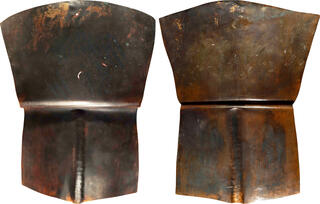| Stack's Bowers Galleries (& Ponterio) > January 2024 NYINC Auction | Auction date: 12 January 2024 |
| Lot number: 53001 Price realized: 2,000 USD (Approx. 1,824 EUR) Note: Prices do not include buyer's fees. | Show similar lots on CoinArchives Find similar lots in upcoming auctions on |
| Lot description: CANADA. Pacific Northwest. British Colombia or Alaska. Tinnah, Taus or "Copper Shield", ND (ca. 20th century). Opitz-pg. 303-305. Weight: Approximately 500 gms. Approximately 16 3/4 in. X 12 1/2 in. (measured at widest). This nicely preserved and wholly original looking example displays lovely rich brown patina with areas of red copper and tan coloration adding a bit of contrast. The upper face depicts what appears to be a stylized Raven done in black paint with red and white accents on the eye and claws. Much of the original surface texture has remained intact, long since toned over, with hammer marks and scratches used in the shaping and manufacturing process. A highly interesting and seldom encountered aspect of First Peoples history that is sure add depth to the next collection it enters. The use of copper in the Pacific Northwest can be traced back more than 2,000 years and appears to have been an early medium of exchange as well as used in warfare. According to tradition copper originated in the Eyak people's territory in the Copper River area of Alaska, where it can be found as pure nuggets in riverbeds. Used in Potlatches, a gift-giving feast or ceremony, Tinnahs or Copper Shields were a sign of wealth, power and importance. The Haida, Nuxalk, Tsimshian, Kwakiutl and Tlingit tribes are all known to have cherished and used such pieces, each with their own styles and depictions, though there is some overlap making it difficult to discern its tribe of origin. When presented to an individual, along with other valuable and precious objects, it was considered massively disrespectful and humiliating not to accept such a gift. It meant that the individual was poor and unable to "pay their debt" when it came time to reciprocate later. In some instances, depending on the nature of the transgression a Tinnah would be broken and presented to the offending party. If the offence was particularly heinous the Tinnah may even be thrown into the ocean, a fire or destroyed all together. For a period, Potlatches were banned in Canada, 1884-1951, the government felt that they were hindering assimilation and even criminalized their attendance. Not only was the ban counterproductive and largely unenforceable, the practice continued and moved underground until the ban was lifted in 1951 and has re-emerged in some communities. Ex: Kenneth L. Hallenbeck Collection. Estimate: $1000 - $2000 |  |



